Veterans Treatment Courts: A Review of Related Literature and Program Description
VerifiedAdded on 2023/06/12
|16
|4491
|329
AI Summary
This article provides a review of related literature and program description of Veterans Treatment Courts. It discusses the problem statement, objectives, and methods used in the study. It also covers the subject of mental health disorders among veterans and the effectiveness of VTCs in addressing them.
Contribute Materials
Your contribution can guide someone’s learning journey. Share your
documents today.
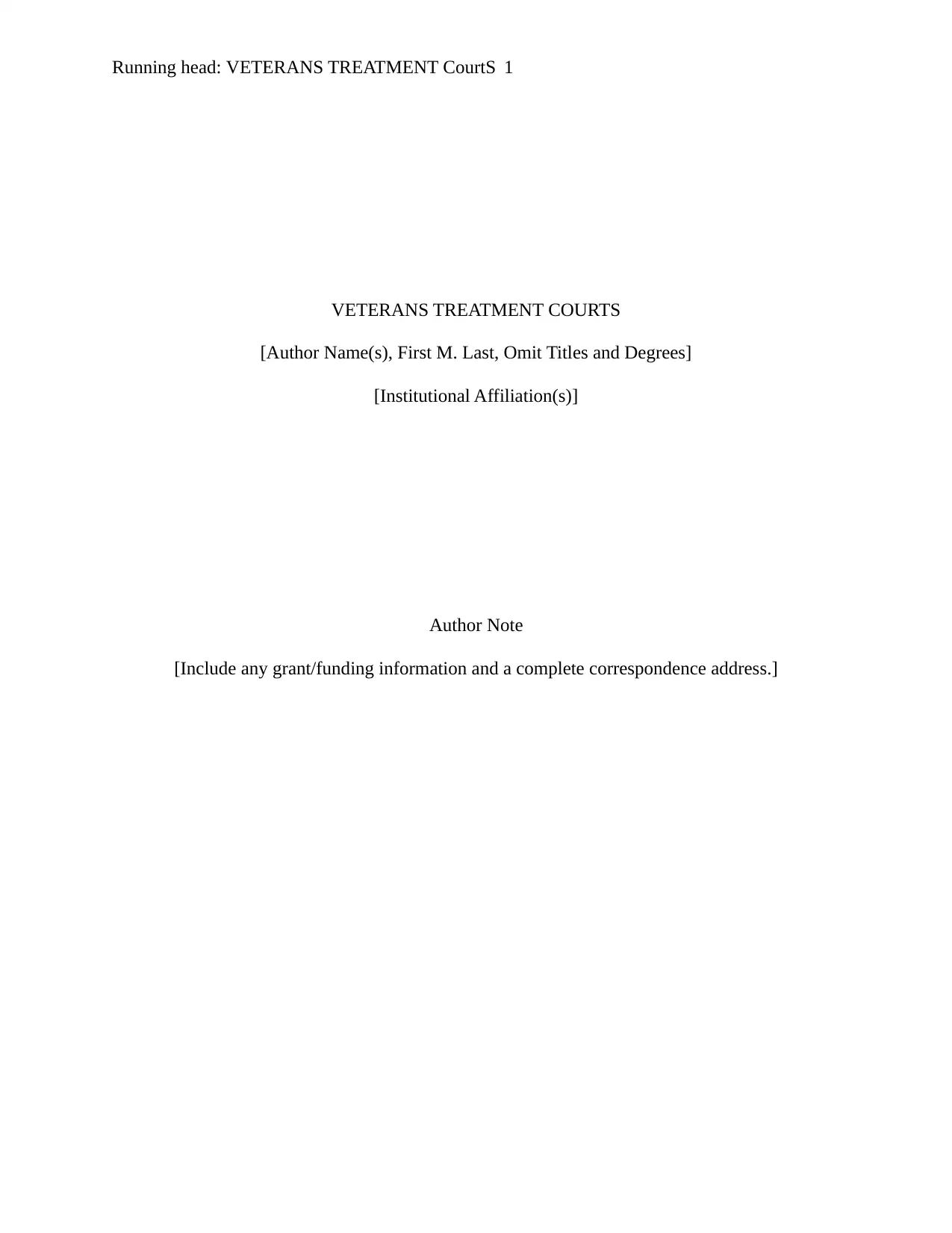
Running head: VETERANS TREATMENT CourtS 1
VETERANS TREATMENT COURTS
[Author Name(s), First M. Last, Omit Titles and Degrees]
[Institutional Affiliation(s)]
Author Note
[Include any grant/funding information and a complete correspondence address.]
VETERANS TREATMENT COURTS
[Author Name(s), First M. Last, Omit Titles and Degrees]
[Institutional Affiliation(s)]
Author Note
[Include any grant/funding information and a complete correspondence address.]
Secure Best Marks with AI Grader
Need help grading? Try our AI Grader for instant feedback on your assignments.
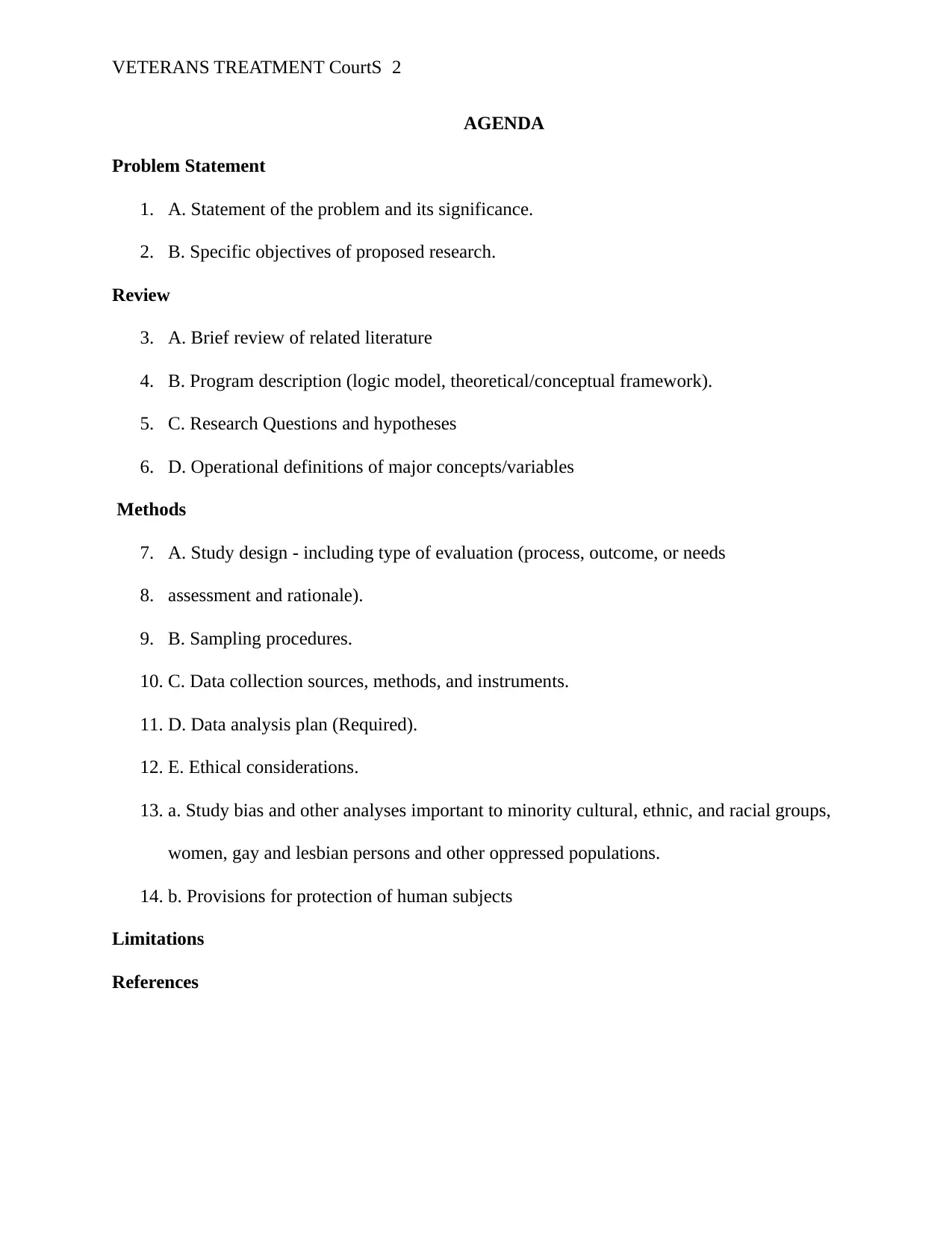
VETERANS TREATMENT CourtS 2
AGENDA
Problem Statement
1. A. Statement of the problem and its significance.
2. B. Specific objectives of proposed research.
Review
3. A. Brief review of related literature
4. B. Program description (logic model, theoretical/conceptual framework).
5. C. Research Questions and hypotheses
6. D. Operational definitions of major concepts/variables
Methods
7. A. Study design - including type of evaluation (process, outcome, or needs
8. assessment and rationale).
9. B. Sampling procedures.
10. C. Data collection sources, methods, and instruments.
11. D. Data analysis plan (Required).
12. E. Ethical considerations.
13. a. Study bias and other analyses important to minority cultural, ethnic, and racial groups,
women, gay and lesbian persons and other oppressed populations.
14. b. Provisions for protection of human subjects
Limitations
References
AGENDA
Problem Statement
1. A. Statement of the problem and its significance.
2. B. Specific objectives of proposed research.
Review
3. A. Brief review of related literature
4. B. Program description (logic model, theoretical/conceptual framework).
5. C. Research Questions and hypotheses
6. D. Operational definitions of major concepts/variables
Methods
7. A. Study design - including type of evaluation (process, outcome, or needs
8. assessment and rationale).
9. B. Sampling procedures.
10. C. Data collection sources, methods, and instruments.
11. D. Data analysis plan (Required).
12. E. Ethical considerations.
13. a. Study bias and other analyses important to minority cultural, ethnic, and racial groups,
women, gay and lesbian persons and other oppressed populations.
14. b. Provisions for protection of human subjects
Limitations
References
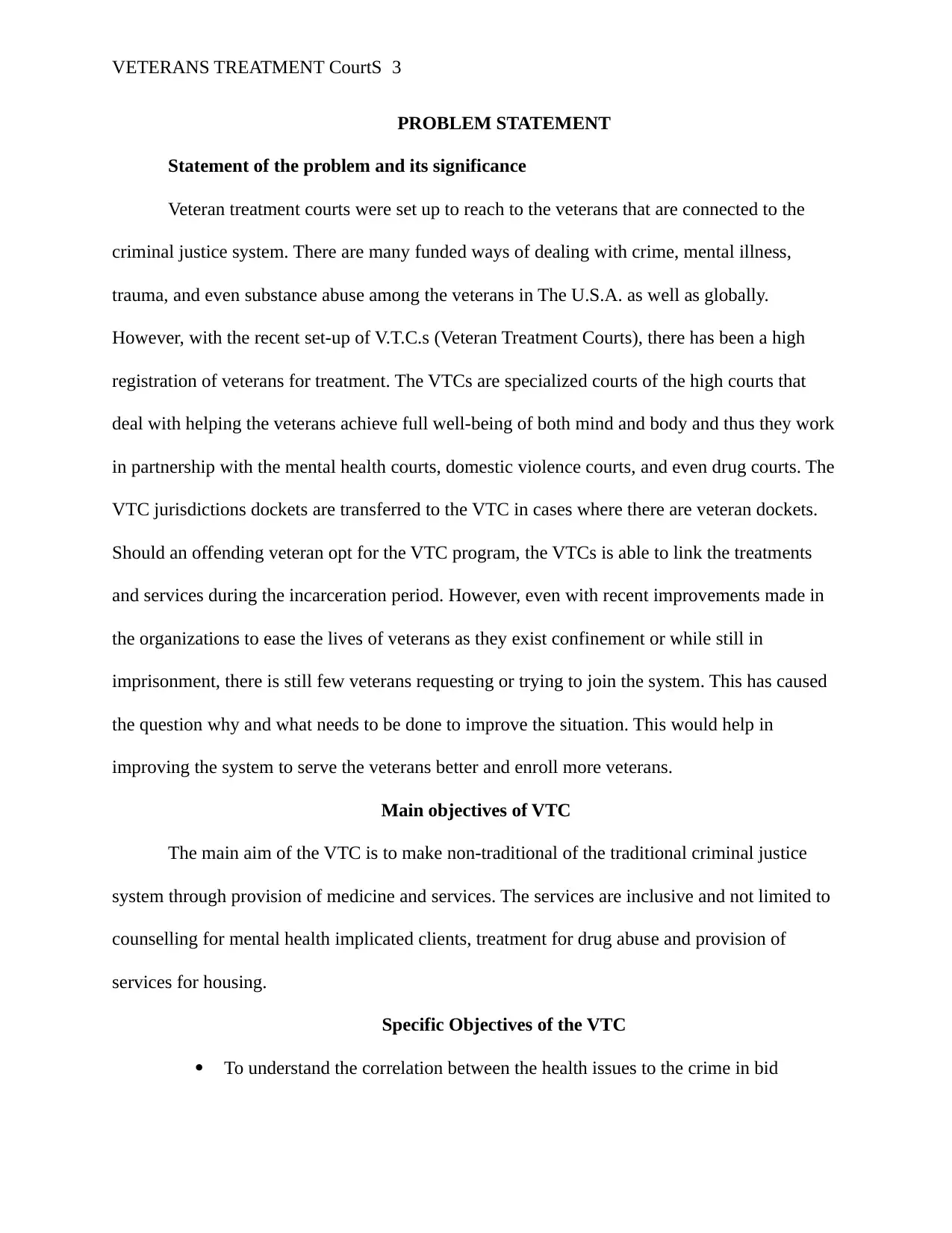
VETERANS TREATMENT CourtS 3
PROBLEM STATEMENT
Statement of the problem and its significance
Veteran treatment courts were set up to reach to the veterans that are connected to the
criminal justice system. There are many funded ways of dealing with crime, mental illness,
trauma, and even substance abuse among the veterans in The U.S.A. as well as globally.
However, with the recent set-up of V.T.C.s (Veteran Treatment Courts), there has been a high
registration of veterans for treatment. The VTCs are specialized courts of the high courts that
deal with helping the veterans achieve full well-being of both mind and body and thus they work
in partnership with the mental health courts, domestic violence courts, and even drug courts. The
VTC jurisdictions dockets are transferred to the VTC in cases where there are veteran dockets.
Should an offending veteran opt for the VTC program, the VTCs is able to link the treatments
and services during the incarceration period. However, even with recent improvements made in
the organizations to ease the lives of veterans as they exist confinement or while still in
imprisonment, there is still few veterans requesting or trying to join the system. This has caused
the question why and what needs to be done to improve the situation. This would help in
improving the system to serve the veterans better and enroll more veterans.
Main objectives of VTC
The main aim of the VTC is to make non-traditional of the traditional criminal justice
system through provision of medicine and services. The services are inclusive and not limited to
counselling for mental health implicated clients, treatment for drug abuse and provision of
services for housing.
Specific Objectives of the VTC
To understand the correlation between the health issues to the crime in bid
PROBLEM STATEMENT
Statement of the problem and its significance
Veteran treatment courts were set up to reach to the veterans that are connected to the
criminal justice system. There are many funded ways of dealing with crime, mental illness,
trauma, and even substance abuse among the veterans in The U.S.A. as well as globally.
However, with the recent set-up of V.T.C.s (Veteran Treatment Courts), there has been a high
registration of veterans for treatment. The VTCs are specialized courts of the high courts that
deal with helping the veterans achieve full well-being of both mind and body and thus they work
in partnership with the mental health courts, domestic violence courts, and even drug courts. The
VTC jurisdictions dockets are transferred to the VTC in cases where there are veteran dockets.
Should an offending veteran opt for the VTC program, the VTCs is able to link the treatments
and services during the incarceration period. However, even with recent improvements made in
the organizations to ease the lives of veterans as they exist confinement or while still in
imprisonment, there is still few veterans requesting or trying to join the system. This has caused
the question why and what needs to be done to improve the situation. This would help in
improving the system to serve the veterans better and enroll more veterans.
Main objectives of VTC
The main aim of the VTC is to make non-traditional of the traditional criminal justice
system through provision of medicine and services. The services are inclusive and not limited to
counselling for mental health implicated clients, treatment for drug abuse and provision of
services for housing.
Specific Objectives of the VTC
To understand the correlation between the health issues to the crime in bid
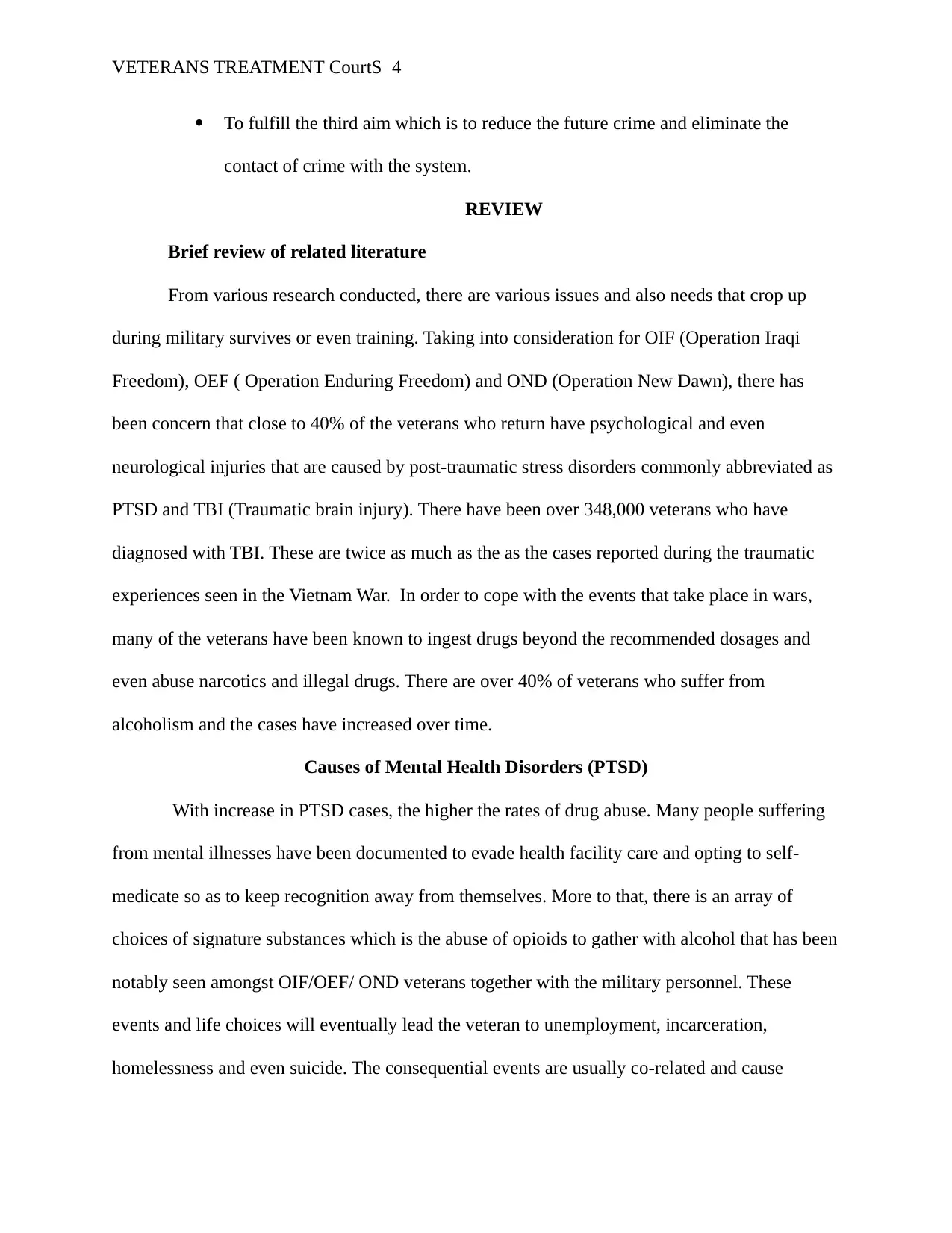
VETERANS TREATMENT CourtS 4
To fulfill the third aim which is to reduce the future crime and eliminate the
contact of crime with the system.
REVIEW
Brief review of related literature
From various research conducted, there are various issues and also needs that crop up
during military survives or even training. Taking into consideration for OIF (Operation Iraqi
Freedom), OEF ( Operation Enduring Freedom) and OND (Operation New Dawn), there has
been concern that close to 40% of the veterans who return have psychological and even
neurological injuries that are caused by post-traumatic stress disorders commonly abbreviated as
PTSD and TBI (Traumatic brain injury). There have been over 348,000 veterans who have
diagnosed with TBI. These are twice as much as the as the cases reported during the traumatic
experiences seen in the Vietnam War. In order to cope with the events that take place in wars,
many of the veterans have been known to ingest drugs beyond the recommended dosages and
even abuse narcotics and illegal drugs. There are over 40% of veterans who suffer from
alcoholism and the cases have increased over time.
Causes of Mental Health Disorders (PTSD)
With increase in PTSD cases, the higher the rates of drug abuse. Many people suffering
from mental illnesses have been documented to evade health facility care and opting to self-
medicate so as to keep recognition away from themselves. More to that, there is an array of
choices of signature substances which is the abuse of opioids to gather with alcohol that has been
notably seen amongst OIF/OEF/ OND veterans together with the military personnel. These
events and life choices will eventually lead the veteran to unemployment, incarceration,
homelessness and even suicide. The consequential events are usually co-related and cause
To fulfill the third aim which is to reduce the future crime and eliminate the
contact of crime with the system.
REVIEW
Brief review of related literature
From various research conducted, there are various issues and also needs that crop up
during military survives or even training. Taking into consideration for OIF (Operation Iraqi
Freedom), OEF ( Operation Enduring Freedom) and OND (Operation New Dawn), there has
been concern that close to 40% of the veterans who return have psychological and even
neurological injuries that are caused by post-traumatic stress disorders commonly abbreviated as
PTSD and TBI (Traumatic brain injury). There have been over 348,000 veterans who have
diagnosed with TBI. These are twice as much as the as the cases reported during the traumatic
experiences seen in the Vietnam War. In order to cope with the events that take place in wars,
many of the veterans have been known to ingest drugs beyond the recommended dosages and
even abuse narcotics and illegal drugs. There are over 40% of veterans who suffer from
alcoholism and the cases have increased over time.
Causes of Mental Health Disorders (PTSD)
With increase in PTSD cases, the higher the rates of drug abuse. Many people suffering
from mental illnesses have been documented to evade health facility care and opting to self-
medicate so as to keep recognition away from themselves. More to that, there is an array of
choices of signature substances which is the abuse of opioids to gather with alcohol that has been
notably seen amongst OIF/OEF/ OND veterans together with the military personnel. These
events and life choices will eventually lead the veteran to unemployment, incarceration,
homelessness and even suicide. The consequential events are usually co-related and cause
Secure Best Marks with AI Grader
Need help grading? Try our AI Grader for instant feedback on your assignments.
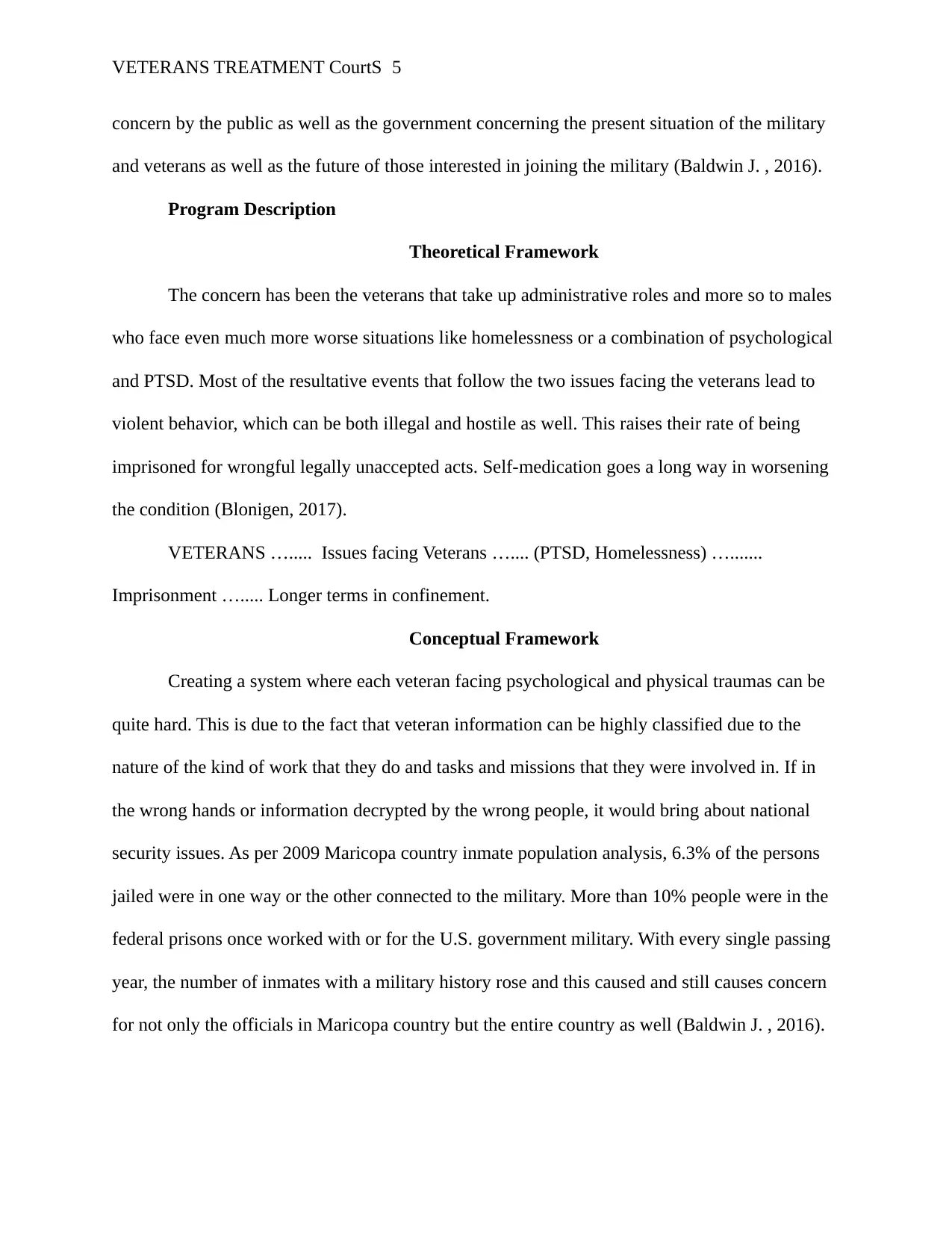
VETERANS TREATMENT CourtS 5
concern by the public as well as the government concerning the present situation of the military
and veterans as well as the future of those interested in joining the military (Baldwin J. , 2016).
Program Description
Theoretical Framework
The concern has been the veterans that take up administrative roles and more so to males
who face even much more worse situations like homelessness or a combination of psychological
and PTSD. Most of the resultative events that follow the two issues facing the veterans lead to
violent behavior, which can be both illegal and hostile as well. This raises their rate of being
imprisoned for wrongful legally unaccepted acts. Self-medication goes a long way in worsening
the condition (Blonigen, 2017).
VETERANS …..... Issues facing Veterans ….... (PTSD, Homelessness) ….......
Imprisonment …..... Longer terms in confinement.
Conceptual Framework
Creating a system where each veteran facing psychological and physical traumas can be
quite hard. This is due to the fact that veteran information can be highly classified due to the
nature of the kind of work that they do and tasks and missions that they were involved in. If in
the wrong hands or information decrypted by the wrong people, it would bring about national
security issues. As per 2009 Maricopa country inmate population analysis, 6.3% of the persons
jailed were in one way or the other connected to the military. More than 10% people were in the
federal prisons once worked with or for the U.S. government military. With every single passing
year, the number of inmates with a military history rose and this caused and still causes concern
for not only the officials in Maricopa country but the entire country as well (Baldwin J. , 2016).
concern by the public as well as the government concerning the present situation of the military
and veterans as well as the future of those interested in joining the military (Baldwin J. , 2016).
Program Description
Theoretical Framework
The concern has been the veterans that take up administrative roles and more so to males
who face even much more worse situations like homelessness or a combination of psychological
and PTSD. Most of the resultative events that follow the two issues facing the veterans lead to
violent behavior, which can be both illegal and hostile as well. This raises their rate of being
imprisoned for wrongful legally unaccepted acts. Self-medication goes a long way in worsening
the condition (Blonigen, 2017).
VETERANS …..... Issues facing Veterans ….... (PTSD, Homelessness) ….......
Imprisonment …..... Longer terms in confinement.
Conceptual Framework
Creating a system where each veteran facing psychological and physical traumas can be
quite hard. This is due to the fact that veteran information can be highly classified due to the
nature of the kind of work that they do and tasks and missions that they were involved in. If in
the wrong hands or information decrypted by the wrong people, it would bring about national
security issues. As per 2009 Maricopa country inmate population analysis, 6.3% of the persons
jailed were in one way or the other connected to the military. More than 10% people were in the
federal prisons once worked with or for the U.S. government military. With every single passing
year, the number of inmates with a military history rose and this caused and still causes concern
for not only the officials in Maricopa country but the entire country as well (Baldwin J. , 2016).
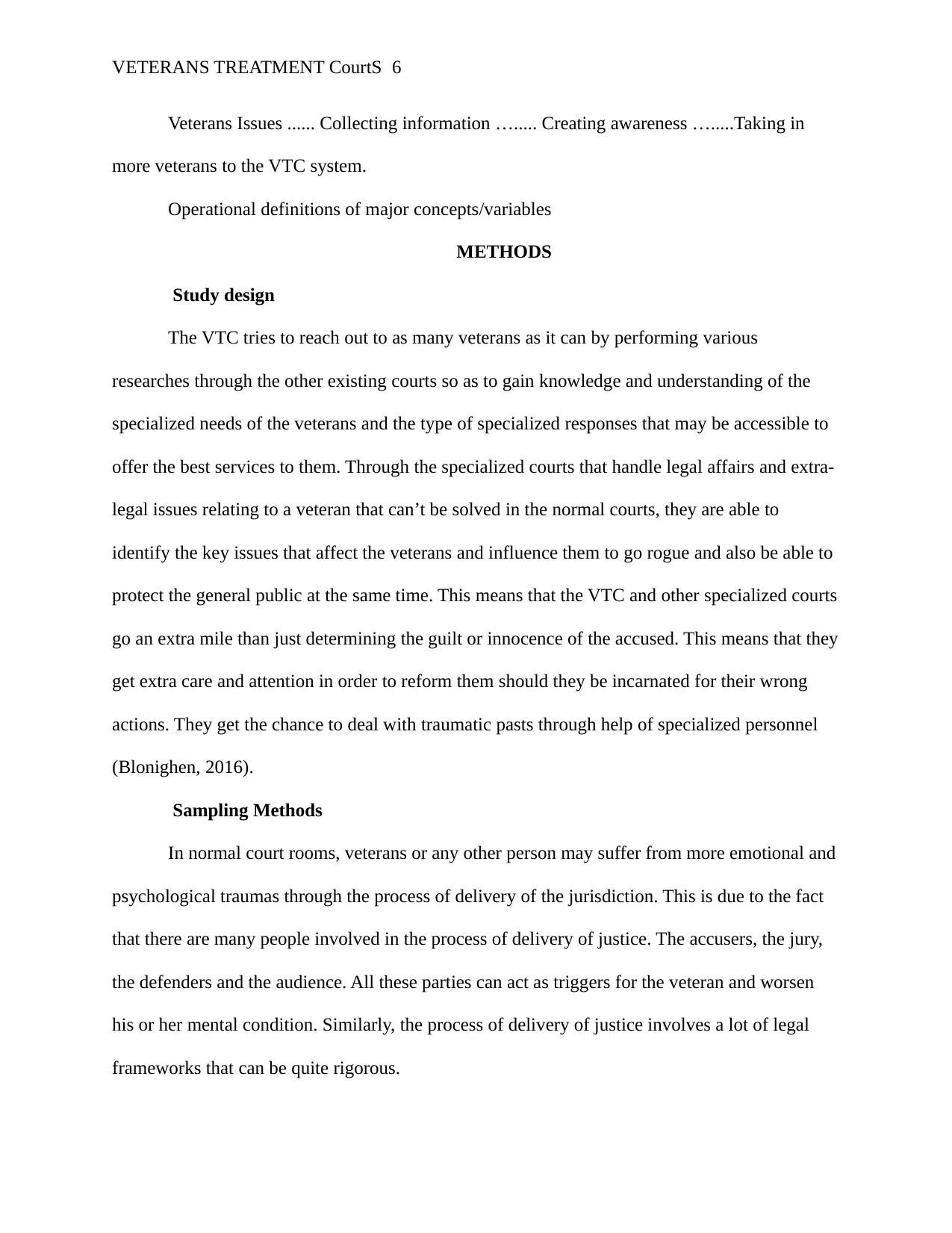
VETERANS TREATMENT CourtS 6
Veterans Issues ...... Collecting information …..... Creating awareness ….....Taking in
more veterans to the VTC system.
Operational definitions of major concepts/variables
METHODS
Study design
The VTC tries to reach out to as many veterans as it can by performing various
researches through the other existing courts so as to gain knowledge and understanding of the
specialized needs of the veterans and the type of specialized responses that may be accessible to
offer the best services to them. Through the specialized courts that handle legal affairs and extra-
legal issues relating to a veteran that can’t be solved in the normal courts, they are able to
identify the key issues that affect the veterans and influence them to go rogue and also be able to
protect the general public at the same time. This means that the VTC and other specialized courts
go an extra mile than just determining the guilt or innocence of the accused. This means that they
get extra care and attention in order to reform them should they be incarnated for their wrong
actions. They get the chance to deal with traumatic pasts through help of specialized personnel
(Blonighen, 2016).
Sampling Methods
In normal court rooms, veterans or any other person may suffer from more emotional and
psychological traumas through the process of delivery of the jurisdiction. This is due to the fact
that there are many people involved in the process of delivery of justice. The accusers, the jury,
the defenders and the audience. All these parties can act as triggers for the veteran and worsen
his or her mental condition. Similarly, the process of delivery of justice involves a lot of legal
frameworks that can be quite rigorous.
Veterans Issues ...... Collecting information …..... Creating awareness ….....Taking in
more veterans to the VTC system.
Operational definitions of major concepts/variables
METHODS
Study design
The VTC tries to reach out to as many veterans as it can by performing various
researches through the other existing courts so as to gain knowledge and understanding of the
specialized needs of the veterans and the type of specialized responses that may be accessible to
offer the best services to them. Through the specialized courts that handle legal affairs and extra-
legal issues relating to a veteran that can’t be solved in the normal courts, they are able to
identify the key issues that affect the veterans and influence them to go rogue and also be able to
protect the general public at the same time. This means that the VTC and other specialized courts
go an extra mile than just determining the guilt or innocence of the accused. This means that they
get extra care and attention in order to reform them should they be incarnated for their wrong
actions. They get the chance to deal with traumatic pasts through help of specialized personnel
(Blonighen, 2016).
Sampling Methods
In normal court rooms, veterans or any other person may suffer from more emotional and
psychological traumas through the process of delivery of the jurisdiction. This is due to the fact
that there are many people involved in the process of delivery of justice. The accusers, the jury,
the defenders and the audience. All these parties can act as triggers for the veteran and worsen
his or her mental condition. Similarly, the process of delivery of justice involves a lot of legal
frameworks that can be quite rigorous.
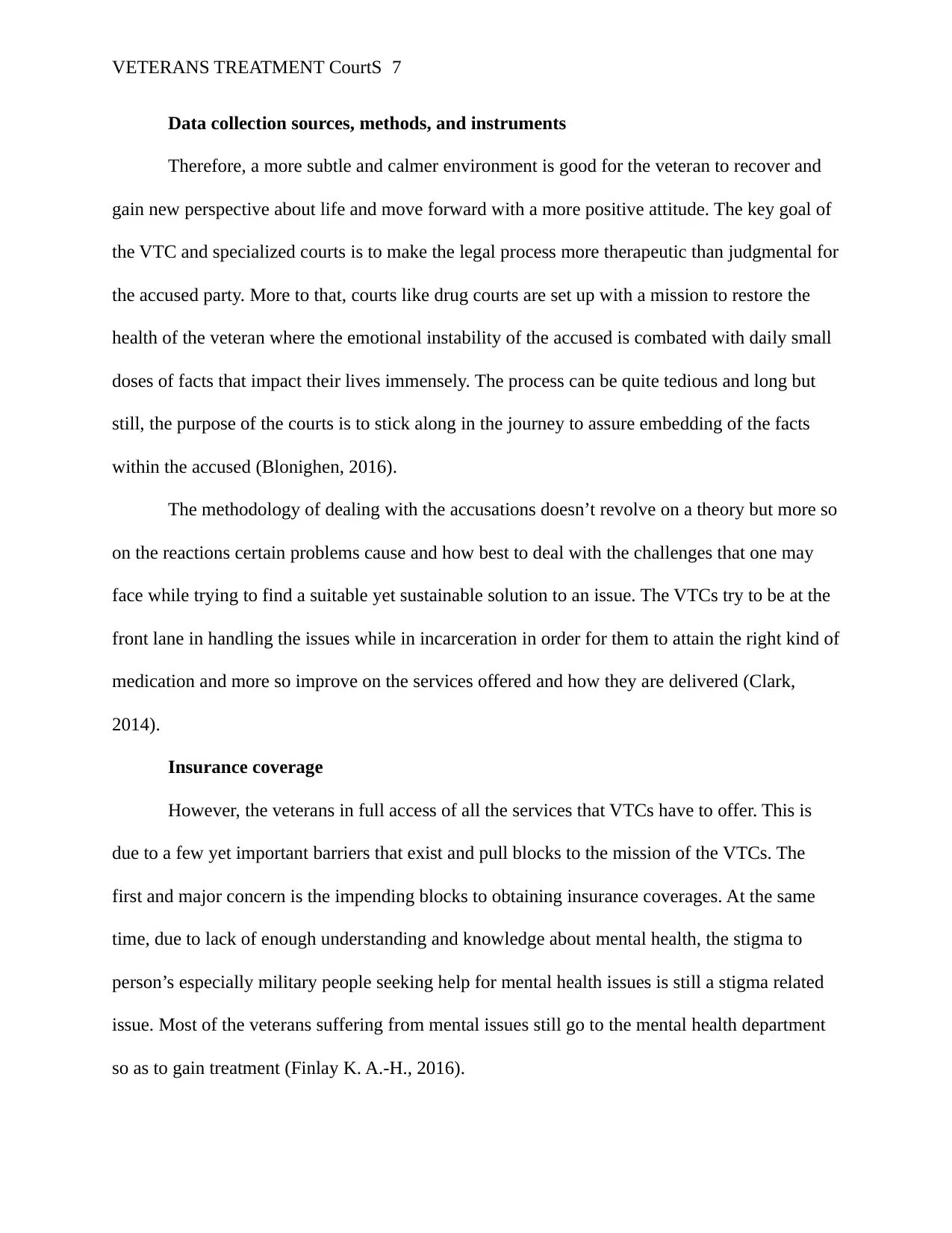
VETERANS TREATMENT CourtS 7
Data collection sources, methods, and instruments
Therefore, a more subtle and calmer environment is good for the veteran to recover and
gain new perspective about life and move forward with a more positive attitude. The key goal of
the VTC and specialized courts is to make the legal process more therapeutic than judgmental for
the accused party. More to that, courts like drug courts are set up with a mission to restore the
health of the veteran where the emotional instability of the accused is combated with daily small
doses of facts that impact their lives immensely. The process can be quite tedious and long but
still, the purpose of the courts is to stick along in the journey to assure embedding of the facts
within the accused (Blonighen, 2016).
The methodology of dealing with the accusations doesn’t revolve on a theory but more so
on the reactions certain problems cause and how best to deal with the challenges that one may
face while trying to find a suitable yet sustainable solution to an issue. The VTCs try to be at the
front lane in handling the issues while in incarceration in order for them to attain the right kind of
medication and more so improve on the services offered and how they are delivered (Clark,
2014).
Insurance coverage
However, the veterans in full access of all the services that VTCs have to offer. This is
due to a few yet important barriers that exist and pull blocks to the mission of the VTCs. The
first and major concern is the impending blocks to obtaining insurance coverages. At the same
time, due to lack of enough understanding and knowledge about mental health, the stigma to
person’s especially military people seeking help for mental health issues is still a stigma related
issue. Most of the veterans suffering from mental issues still go to the mental health department
so as to gain treatment (Finlay K. A.-H., 2016).
Data collection sources, methods, and instruments
Therefore, a more subtle and calmer environment is good for the veteran to recover and
gain new perspective about life and move forward with a more positive attitude. The key goal of
the VTC and specialized courts is to make the legal process more therapeutic than judgmental for
the accused party. More to that, courts like drug courts are set up with a mission to restore the
health of the veteran where the emotional instability of the accused is combated with daily small
doses of facts that impact their lives immensely. The process can be quite tedious and long but
still, the purpose of the courts is to stick along in the journey to assure embedding of the facts
within the accused (Blonighen, 2016).
The methodology of dealing with the accusations doesn’t revolve on a theory but more so
on the reactions certain problems cause and how best to deal with the challenges that one may
face while trying to find a suitable yet sustainable solution to an issue. The VTCs try to be at the
front lane in handling the issues while in incarceration in order for them to attain the right kind of
medication and more so improve on the services offered and how they are delivered (Clark,
2014).
Insurance coverage
However, the veterans in full access of all the services that VTCs have to offer. This is
due to a few yet important barriers that exist and pull blocks to the mission of the VTCs. The
first and major concern is the impending blocks to obtaining insurance coverages. At the same
time, due to lack of enough understanding and knowledge about mental health, the stigma to
person’s especially military people seeking help for mental health issues is still a stigma related
issue. Most of the veterans suffering from mental issues still go to the mental health department
so as to gain treatment (Finlay K. A.-H., 2016).
Paraphrase This Document
Need a fresh take? Get an instant paraphrase of this document with our AI Paraphraser

VETERANS TREATMENT CourtS 8
Legalities
There is also the issue of too many legalities and paper work that see are inclusive of
discharge status, the period of military service, the years active and number of completed tasks as
well as absence of felony warrants. There are determinations made ranging from zero
involvement in felonies and there can be an extension on the amount of time one is incarnated or
paroled. This makes the VTCs program a bit inaccessible and the adder part is the contribution of
influence of infrastructure and societal belief and law from giving the veteran the right kind of
medical assistance which isn’t provided by the healthcare (Finlay K. A.-H., 2016).
Stigma
More just inaccessibility the issue of veteran resistance to accepting the condition let
alone agreeing to receive mental health care, the negativity of perceptions and action directly
contributes to making a fearful person suffering from mental issues more irritated and especially
when it comes to those suffering from the conditions. Conditions like depression, anxiety and
depression amongst others tend to bring about more criticism and more so cause obstruction of
healthcare given to those suffering from the illness. There is also the case of the media and
reports that create light of the institution and yet also causes horrible review due to over merging
of both activities. Articles have sought to clearly explain what VTC is and even more so provide
information on the importance of VTC and how the people perceive it and how it performs in
different parts of the country (Finlay K. A.-H., 2016).
Data Analysis Plan
Effectiveness of the VTC
Key measures
Legalities
There is also the issue of too many legalities and paper work that see are inclusive of
discharge status, the period of military service, the years active and number of completed tasks as
well as absence of felony warrants. There are determinations made ranging from zero
involvement in felonies and there can be an extension on the amount of time one is incarnated or
paroled. This makes the VTCs program a bit inaccessible and the adder part is the contribution of
influence of infrastructure and societal belief and law from giving the veteran the right kind of
medical assistance which isn’t provided by the healthcare (Finlay K. A.-H., 2016).
Stigma
More just inaccessibility the issue of veteran resistance to accepting the condition let
alone agreeing to receive mental health care, the negativity of perceptions and action directly
contributes to making a fearful person suffering from mental issues more irritated and especially
when it comes to those suffering from the conditions. Conditions like depression, anxiety and
depression amongst others tend to bring about more criticism and more so cause obstruction of
healthcare given to those suffering from the illness. There is also the case of the media and
reports that create light of the institution and yet also causes horrible review due to over merging
of both activities. Articles have sought to clearly explain what VTC is and even more so provide
information on the importance of VTC and how the people perceive it and how it performs in
different parts of the country (Finlay K. A.-H., 2016).
Data Analysis Plan
Effectiveness of the VTC
Key measures
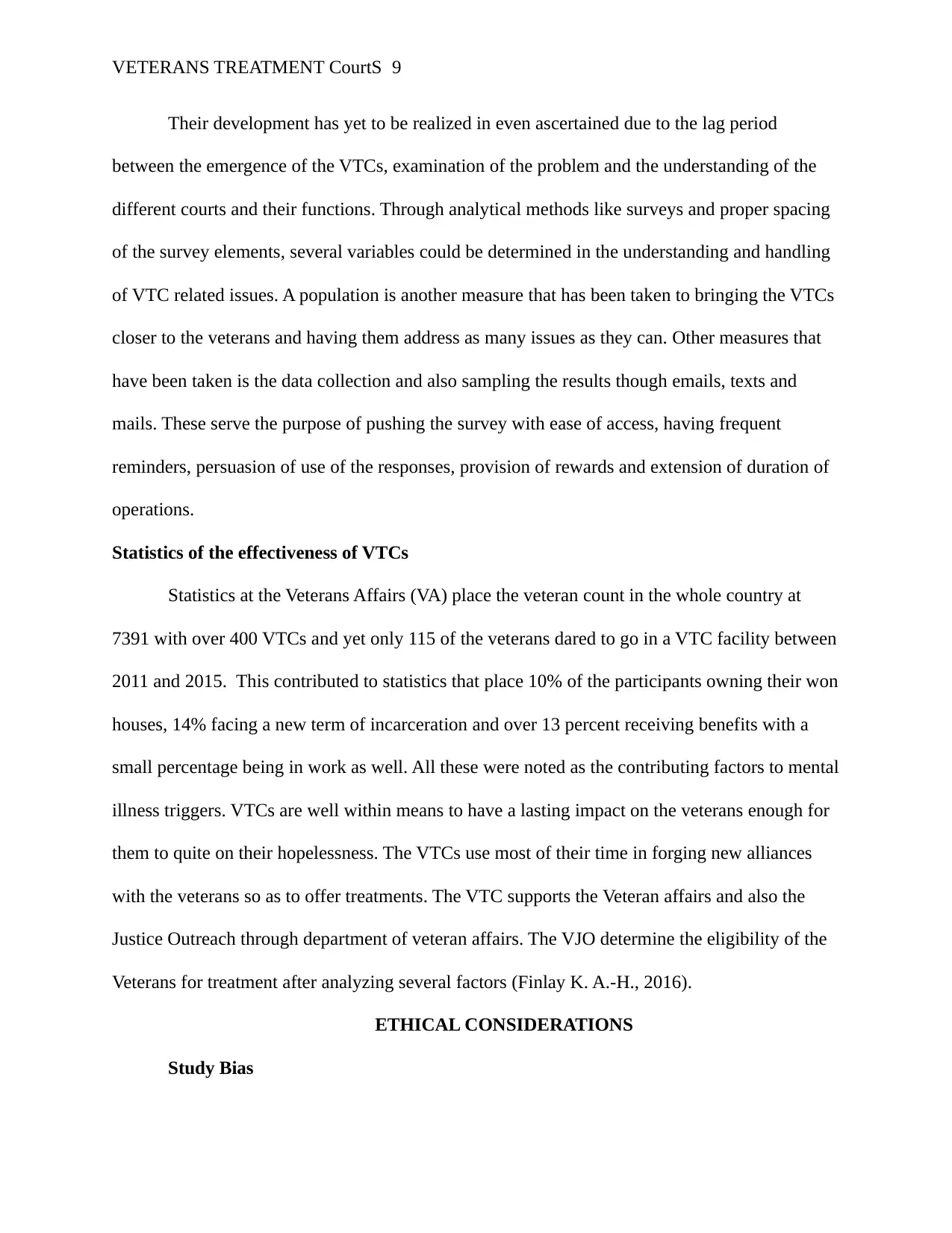
VETERANS TREATMENT CourtS 9
Their development has yet to be realized in even ascertained due to the lag period
between the emergence of the VTCs, examination of the problem and the understanding of the
different courts and their functions. Through analytical methods like surveys and proper spacing
of the survey elements, several variables could be determined in the understanding and handling
of VTC related issues. A population is another measure that has been taken to bringing the VTCs
closer to the veterans and having them address as many issues as they can. Other measures that
have been taken is the data collection and also sampling the results though emails, texts and
mails. These serve the purpose of pushing the survey with ease of access, having frequent
reminders, persuasion of use of the responses, provision of rewards and extension of duration of
operations.
Statistics of the effectiveness of VTCs
Statistics at the Veterans Affairs (VA) place the veteran count in the whole country at
7391 with over 400 VTCs and yet only 115 of the veterans dared to go in a VTC facility between
2011 and 2015. This contributed to statistics that place 10% of the participants owning their won
houses, 14% facing a new term of incarceration and over 13 percent receiving benefits with a
small percentage being in work as well. All these were noted as the contributing factors to mental
illness triggers. VTCs are well within means to have a lasting impact on the veterans enough for
them to quite on their hopelessness. The VTCs use most of their time in forging new alliances
with the veterans so as to offer treatments. The VTC supports the Veteran affairs and also the
Justice Outreach through department of veteran affairs. The VJO determine the eligibility of the
Veterans for treatment after analyzing several factors (Finlay K. A.-H., 2016).
ETHICAL CONSIDERATIONS
Study Bias
Their development has yet to be realized in even ascertained due to the lag period
between the emergence of the VTCs, examination of the problem and the understanding of the
different courts and their functions. Through analytical methods like surveys and proper spacing
of the survey elements, several variables could be determined in the understanding and handling
of VTC related issues. A population is another measure that has been taken to bringing the VTCs
closer to the veterans and having them address as many issues as they can. Other measures that
have been taken is the data collection and also sampling the results though emails, texts and
mails. These serve the purpose of pushing the survey with ease of access, having frequent
reminders, persuasion of use of the responses, provision of rewards and extension of duration of
operations.
Statistics of the effectiveness of VTCs
Statistics at the Veterans Affairs (VA) place the veteran count in the whole country at
7391 with over 400 VTCs and yet only 115 of the veterans dared to go in a VTC facility between
2011 and 2015. This contributed to statistics that place 10% of the participants owning their won
houses, 14% facing a new term of incarceration and over 13 percent receiving benefits with a
small percentage being in work as well. All these were noted as the contributing factors to mental
illness triggers. VTCs are well within means to have a lasting impact on the veterans enough for
them to quite on their hopelessness. The VTCs use most of their time in forging new alliances
with the veterans so as to offer treatments. The VTC supports the Veteran affairs and also the
Justice Outreach through department of veteran affairs. The VJO determine the eligibility of the
Veterans for treatment after analyzing several factors (Finlay K. A.-H., 2016).
ETHICAL CONSIDERATIONS
Study Bias

VETERANS TREATMENT CourtS 10
The eligibility criteria usually varies across other jurisdictions and thus accused parties
are accepted to the system even with their past charges. There tends to be more concertation on
felonies and acts of misdemeanor at certain percentages. The purpose of the Veterans Justice
Outreach (VJO) seeks to provide incarceration options that seek to control costs. They do so by
selecting the victims in the incarceration facilities who have a history of mental health issues. In
2010-2012, over 36,000 veterans were able to visit the VJO specialists with over 45 years and
above of men and 35 years of for women, there was more involvement from the White
Americans, Black Americans, Singles, and Divorced Americans respectively. Among the
disorders addresses include anxiety disorder, bipolar, personality, cannabis use, cocaine use,
alcohol use and depressive disorders among many others. The many that were signed into the
VJP program, most were diagnosed with mental health disorders with most having substance
abuse disorder as well. The mental health clinics have helped in lessening the mental health
treatment. With over 59% of deaths in prisons accounted to abuse of opioids, there is need to
explore pharmacotherapy therapy among many other options to deal with the disorders. The
medicine are cost-effective in reducing drug and substance abuse and incarceration illegal
activities (Finlay K. A.-H., 2016).
LIMITATIONS
It’s difficult to have these sort of therapy addressed while persons are in jail and thus, the
best form taken is to address the issues while the persons in are in prisons. Patients who have
referrals in the past have been shown to have higher odds of delayed admission into the program
after release from prison. Using veteran Health administration records diagnosis for veterans is
enabled. There were a total of over 46 thousand patients that were diagnosed with mental
disorders among which there were over 4,000 veterans that were involved with justice involved
The eligibility criteria usually varies across other jurisdictions and thus accused parties
are accepted to the system even with their past charges. There tends to be more concertation on
felonies and acts of misdemeanor at certain percentages. The purpose of the Veterans Justice
Outreach (VJO) seeks to provide incarceration options that seek to control costs. They do so by
selecting the victims in the incarceration facilities who have a history of mental health issues. In
2010-2012, over 36,000 veterans were able to visit the VJO specialists with over 45 years and
above of men and 35 years of for women, there was more involvement from the White
Americans, Black Americans, Singles, and Divorced Americans respectively. Among the
disorders addresses include anxiety disorder, bipolar, personality, cannabis use, cocaine use,
alcohol use and depressive disorders among many others. The many that were signed into the
VJP program, most were diagnosed with mental health disorders with most having substance
abuse disorder as well. The mental health clinics have helped in lessening the mental health
treatment. With over 59% of deaths in prisons accounted to abuse of opioids, there is need to
explore pharmacotherapy therapy among many other options to deal with the disorders. The
medicine are cost-effective in reducing drug and substance abuse and incarceration illegal
activities (Finlay K. A.-H., 2016).
LIMITATIONS
It’s difficult to have these sort of therapy addressed while persons are in jail and thus, the
best form taken is to address the issues while the persons in are in prisons. Patients who have
referrals in the past have been shown to have higher odds of delayed admission into the program
after release from prison. Using veteran Health administration records diagnosis for veterans is
enabled. There were a total of over 46 thousand patients that were diagnosed with mental
disorders among which there were over 4,000 veterans that were involved with justice involved
Secure Best Marks with AI Grader
Need help grading? Try our AI Grader for instant feedback on your assignments.
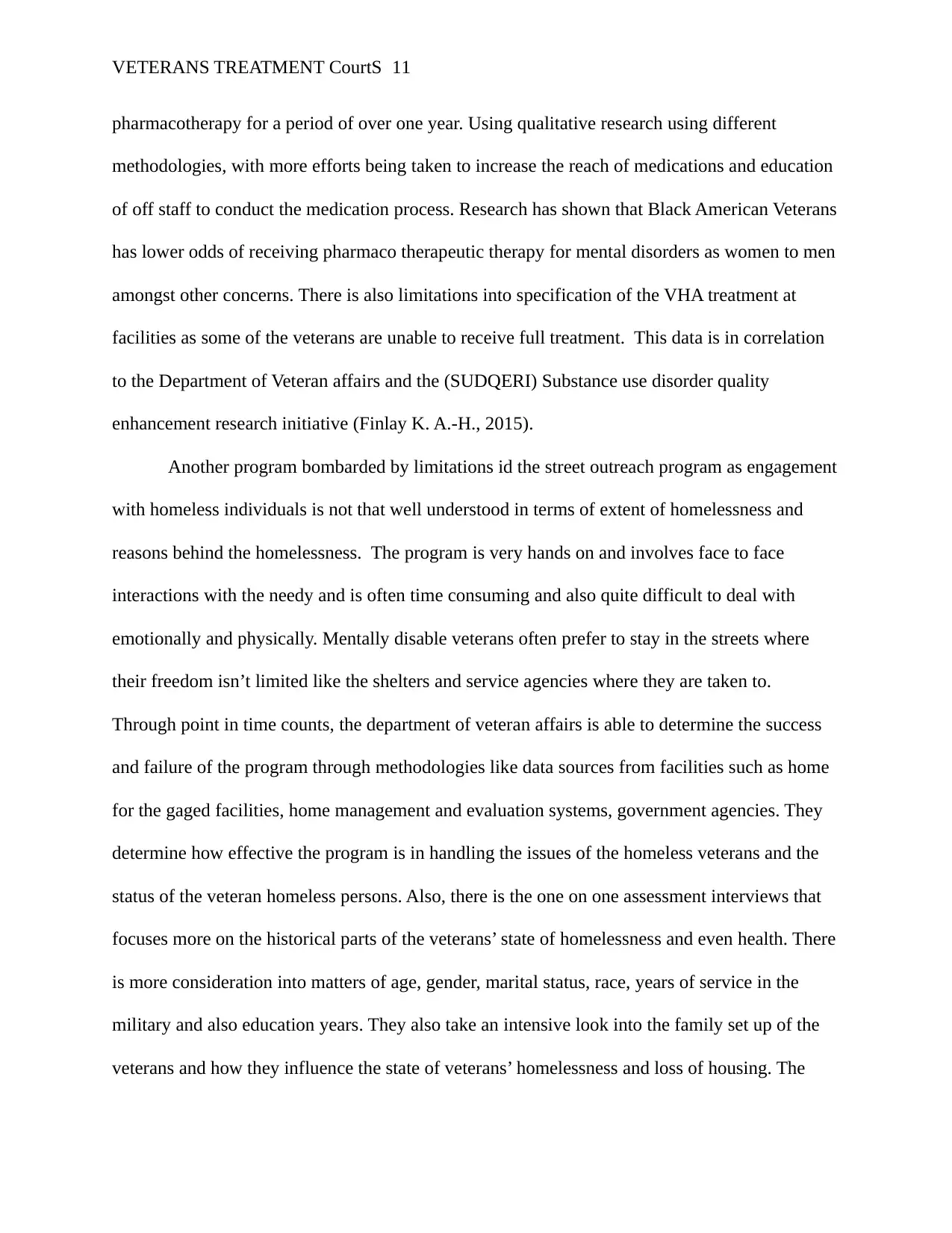
VETERANS TREATMENT CourtS 11
pharmacotherapy for a period of over one year. Using qualitative research using different
methodologies, with more efforts being taken to increase the reach of medications and education
of off staff to conduct the medication process. Research has shown that Black American Veterans
has lower odds of receiving pharmaco therapeutic therapy for mental disorders as women to men
amongst other concerns. There is also limitations into specification of the VHA treatment at
facilities as some of the veterans are unable to receive full treatment. This data is in correlation
to the Department of Veteran affairs and the (SUDQERI) Substance use disorder quality
enhancement research initiative (Finlay K. A.-H., 2015).
Another program bombarded by limitations id the street outreach program as engagement
with homeless individuals is not that well understood in terms of extent of homelessness and
reasons behind the homelessness. The program is very hands on and involves face to face
interactions with the needy and is often time consuming and also quite difficult to deal with
emotionally and physically. Mentally disable veterans often prefer to stay in the streets where
their freedom isn’t limited like the shelters and service agencies where they are taken to.
Through point in time counts, the department of veteran affairs is able to determine the success
and failure of the program through methodologies like data sources from facilities such as home
for the gaged facilities, home management and evaluation systems, government agencies. They
determine how effective the program is in handling the issues of the homeless veterans and the
status of the veteran homeless persons. Also, there is the one on one assessment interviews that
focuses more on the historical parts of the veterans’ state of homelessness and even health. There
is more consideration into matters of age, gender, marital status, race, years of service in the
military and also education years. They also take an intensive look into the family set up of the
veterans and how they influence the state of veterans’ homelessness and loss of housing. The
pharmacotherapy for a period of over one year. Using qualitative research using different
methodologies, with more efforts being taken to increase the reach of medications and education
of off staff to conduct the medication process. Research has shown that Black American Veterans
has lower odds of receiving pharmaco therapeutic therapy for mental disorders as women to men
amongst other concerns. There is also limitations into specification of the VHA treatment at
facilities as some of the veterans are unable to receive full treatment. This data is in correlation
to the Department of Veteran affairs and the (SUDQERI) Substance use disorder quality
enhancement research initiative (Finlay K. A.-H., 2015).
Another program bombarded by limitations id the street outreach program as engagement
with homeless individuals is not that well understood in terms of extent of homelessness and
reasons behind the homelessness. The program is very hands on and involves face to face
interactions with the needy and is often time consuming and also quite difficult to deal with
emotionally and physically. Mentally disable veterans often prefer to stay in the streets where
their freedom isn’t limited like the shelters and service agencies where they are taken to.
Through point in time counts, the department of veteran affairs is able to determine the success
and failure of the program through methodologies like data sources from facilities such as home
for the gaged facilities, home management and evaluation systems, government agencies. They
determine how effective the program is in handling the issues of the homeless veterans and the
status of the veteran homeless persons. Also, there is the one on one assessment interviews that
focuses more on the historical parts of the veterans’ state of homelessness and even health. There
is more consideration into matters of age, gender, marital status, race, years of service in the
military and also education years. They also take an intensive look into the family set up of the
veterans and how they influence the state of veterans’ homelessness and loss of housing. The
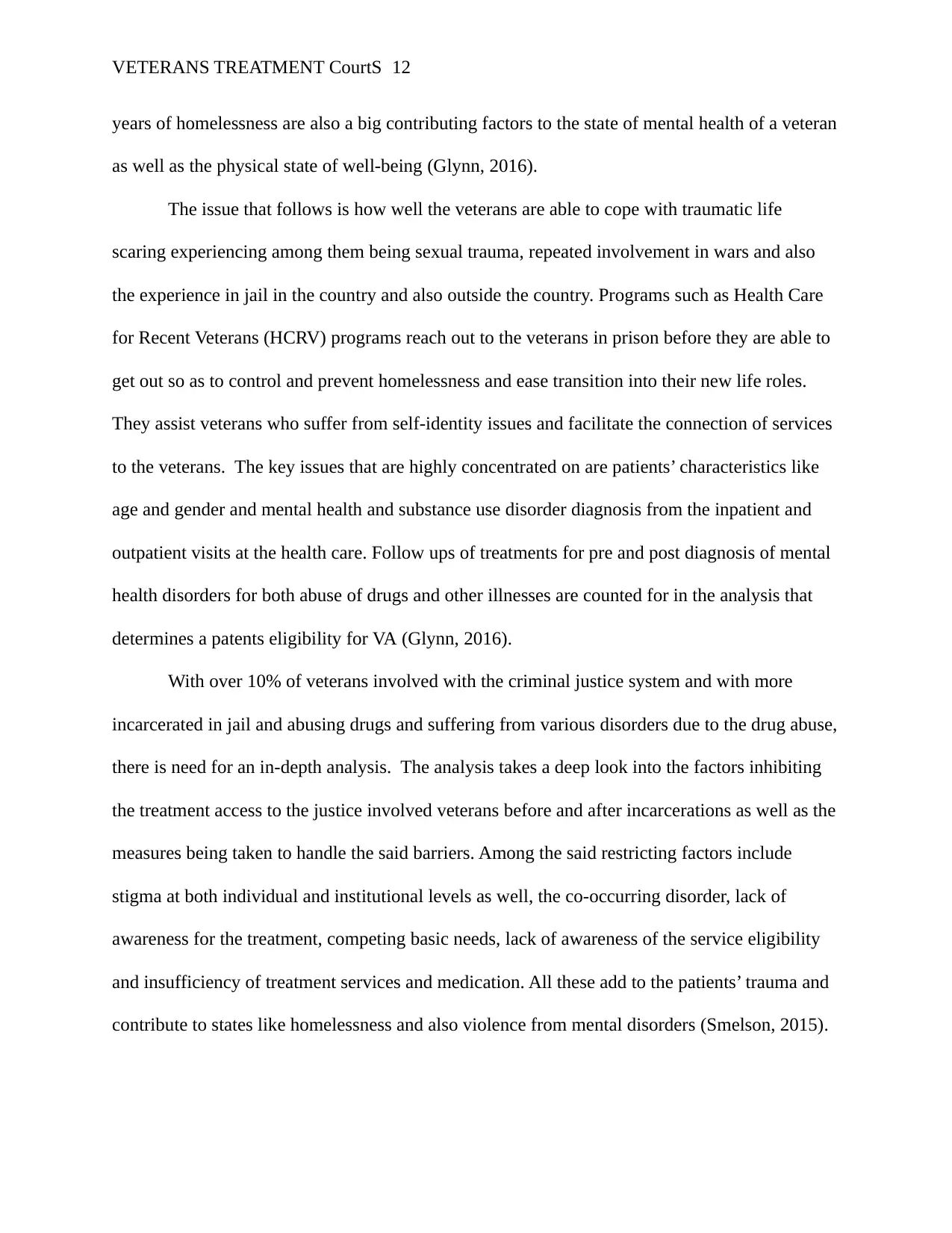
VETERANS TREATMENT CourtS 12
years of homelessness are also a big contributing factors to the state of mental health of a veteran
as well as the physical state of well-being (Glynn, 2016).
The issue that follows is how well the veterans are able to cope with traumatic life
scaring experiencing among them being sexual trauma, repeated involvement in wars and also
the experience in jail in the country and also outside the country. Programs such as Health Care
for Recent Veterans (HCRV) programs reach out to the veterans in prison before they are able to
get out so as to control and prevent homelessness and ease transition into their new life roles.
They assist veterans who suffer from self-identity issues and facilitate the connection of services
to the veterans. The key issues that are highly concentrated on are patients’ characteristics like
age and gender and mental health and substance use disorder diagnosis from the inpatient and
outpatient visits at the health care. Follow ups of treatments for pre and post diagnosis of mental
health disorders for both abuse of drugs and other illnesses are counted for in the analysis that
determines a patents eligibility for VA (Glynn, 2016).
With over 10% of veterans involved with the criminal justice system and with more
incarcerated in jail and abusing drugs and suffering from various disorders due to the drug abuse,
there is need for an in-depth analysis. The analysis takes a deep look into the factors inhibiting
the treatment access to the justice involved veterans before and after incarcerations as well as the
measures being taken to handle the said barriers. Among the said restricting factors include
stigma at both individual and institutional levels as well, the co-occurring disorder, lack of
awareness for the treatment, competing basic needs, lack of awareness of the service eligibility
and insufficiency of treatment services and medication. All these add to the patients’ trauma and
contribute to states like homelessness and also violence from mental disorders (Smelson, 2015).
years of homelessness are also a big contributing factors to the state of mental health of a veteran
as well as the physical state of well-being (Glynn, 2016).
The issue that follows is how well the veterans are able to cope with traumatic life
scaring experiencing among them being sexual trauma, repeated involvement in wars and also
the experience in jail in the country and also outside the country. Programs such as Health Care
for Recent Veterans (HCRV) programs reach out to the veterans in prison before they are able to
get out so as to control and prevent homelessness and ease transition into their new life roles.
They assist veterans who suffer from self-identity issues and facilitate the connection of services
to the veterans. The key issues that are highly concentrated on are patients’ characteristics like
age and gender and mental health and substance use disorder diagnosis from the inpatient and
outpatient visits at the health care. Follow ups of treatments for pre and post diagnosis of mental
health disorders for both abuse of drugs and other illnesses are counted for in the analysis that
determines a patents eligibility for VA (Glynn, 2016).
With over 10% of veterans involved with the criminal justice system and with more
incarcerated in jail and abusing drugs and suffering from various disorders due to the drug abuse,
there is need for an in-depth analysis. The analysis takes a deep look into the factors inhibiting
the treatment access to the justice involved veterans before and after incarcerations as well as the
measures being taken to handle the said barriers. Among the said restricting factors include
stigma at both individual and institutional levels as well, the co-occurring disorder, lack of
awareness for the treatment, competing basic needs, lack of awareness of the service eligibility
and insufficiency of treatment services and medication. All these add to the patients’ trauma and
contribute to states like homelessness and also violence from mental disorders (Smelson, 2015).
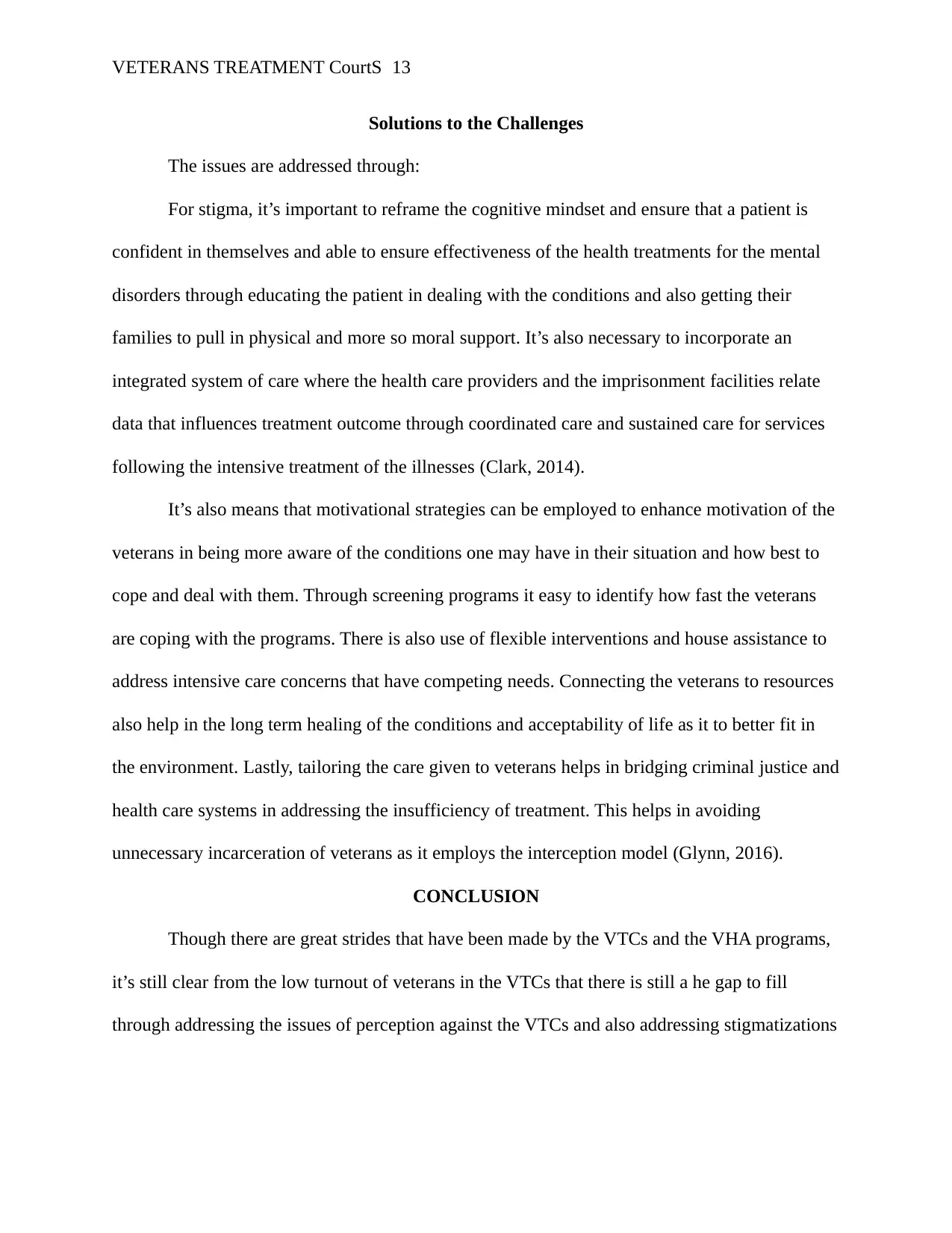
VETERANS TREATMENT CourtS 13
Solutions to the Challenges
The issues are addressed through:
For stigma, it’s important to reframe the cognitive mindset and ensure that a patient is
confident in themselves and able to ensure effectiveness of the health treatments for the mental
disorders through educating the patient in dealing with the conditions and also getting their
families to pull in physical and more so moral support. It’s also necessary to incorporate an
integrated system of care where the health care providers and the imprisonment facilities relate
data that influences treatment outcome through coordinated care and sustained care for services
following the intensive treatment of the illnesses (Clark, 2014).
It’s also means that motivational strategies can be employed to enhance motivation of the
veterans in being more aware of the conditions one may have in their situation and how best to
cope and deal with them. Through screening programs it easy to identify how fast the veterans
are coping with the programs. There is also use of flexible interventions and house assistance to
address intensive care concerns that have competing needs. Connecting the veterans to resources
also help in the long term healing of the conditions and acceptability of life as it to better fit in
the environment. Lastly, tailoring the care given to veterans helps in bridging criminal justice and
health care systems in addressing the insufficiency of treatment. This helps in avoiding
unnecessary incarceration of veterans as it employs the interception model (Glynn, 2016).
CONCLUSION
Though there are great strides that have been made by the VTCs and the VHA programs,
it’s still clear from the low turnout of veterans in the VTCs that there is still a he gap to fill
through addressing the issues of perception against the VTCs and also addressing stigmatizations
Solutions to the Challenges
The issues are addressed through:
For stigma, it’s important to reframe the cognitive mindset and ensure that a patient is
confident in themselves and able to ensure effectiveness of the health treatments for the mental
disorders through educating the patient in dealing with the conditions and also getting their
families to pull in physical and more so moral support. It’s also necessary to incorporate an
integrated system of care where the health care providers and the imprisonment facilities relate
data that influences treatment outcome through coordinated care and sustained care for services
following the intensive treatment of the illnesses (Clark, 2014).
It’s also means that motivational strategies can be employed to enhance motivation of the
veterans in being more aware of the conditions one may have in their situation and how best to
cope and deal with them. Through screening programs it easy to identify how fast the veterans
are coping with the programs. There is also use of flexible interventions and house assistance to
address intensive care concerns that have competing needs. Connecting the veterans to resources
also help in the long term healing of the conditions and acceptability of life as it to better fit in
the environment. Lastly, tailoring the care given to veterans helps in bridging criminal justice and
health care systems in addressing the insufficiency of treatment. This helps in avoiding
unnecessary incarceration of veterans as it employs the interception model (Glynn, 2016).
CONCLUSION
Though there are great strides that have been made by the VTCs and the VHA programs,
it’s still clear from the low turnout of veterans in the VTCs that there is still a he gap to fill
through addressing the issues of perception against the VTCs and also addressing stigmatizations
Paraphrase This Document
Need a fresh take? Get an instant paraphrase of this document with our AI Paraphraser
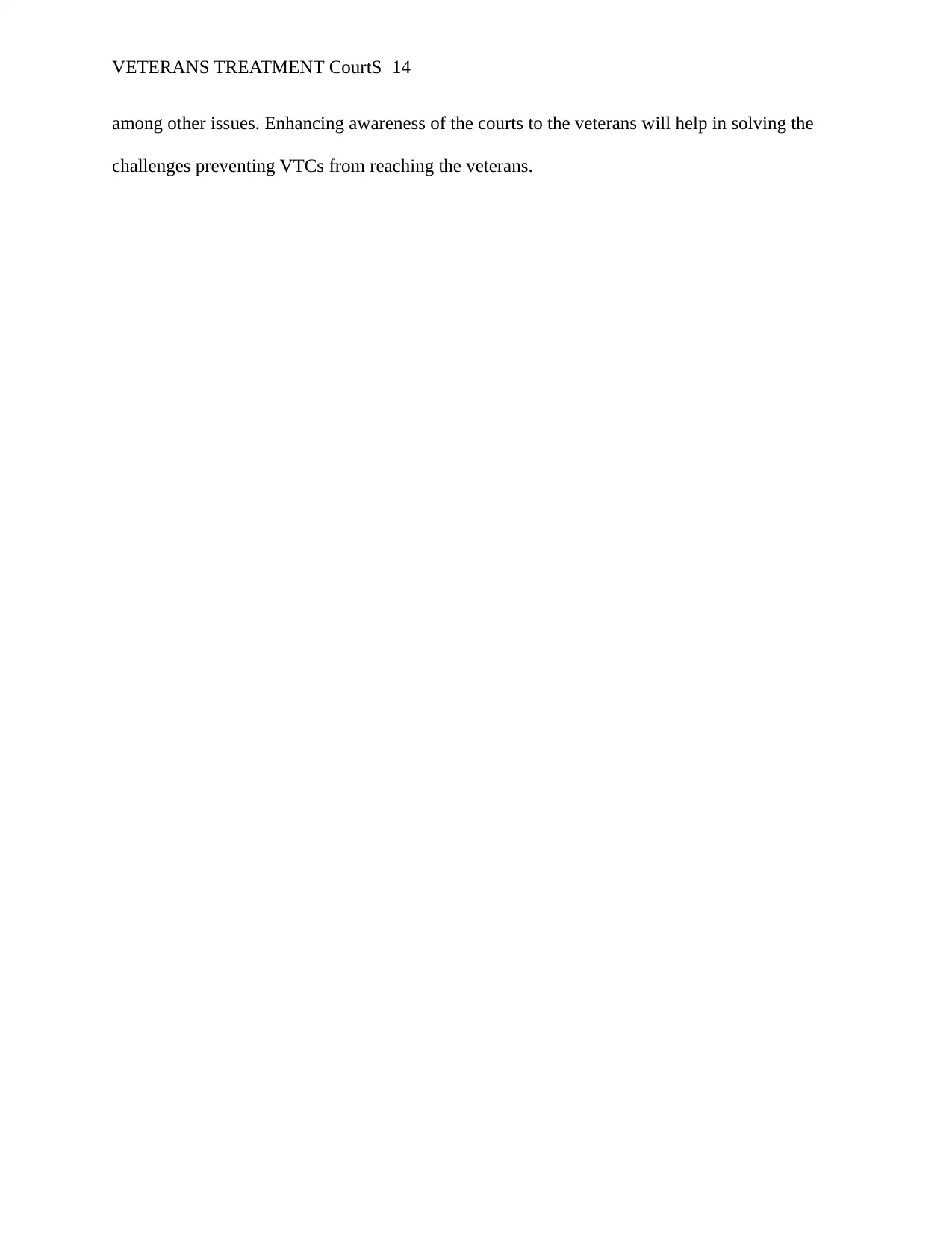
VETERANS TREATMENT CourtS 14
among other issues. Enhancing awareness of the courts to the veterans will help in solving the
challenges preventing VTCs from reaching the veterans.
among other issues. Enhancing awareness of the courts to the veterans will help in solving the
challenges preventing VTCs from reaching the veterans.
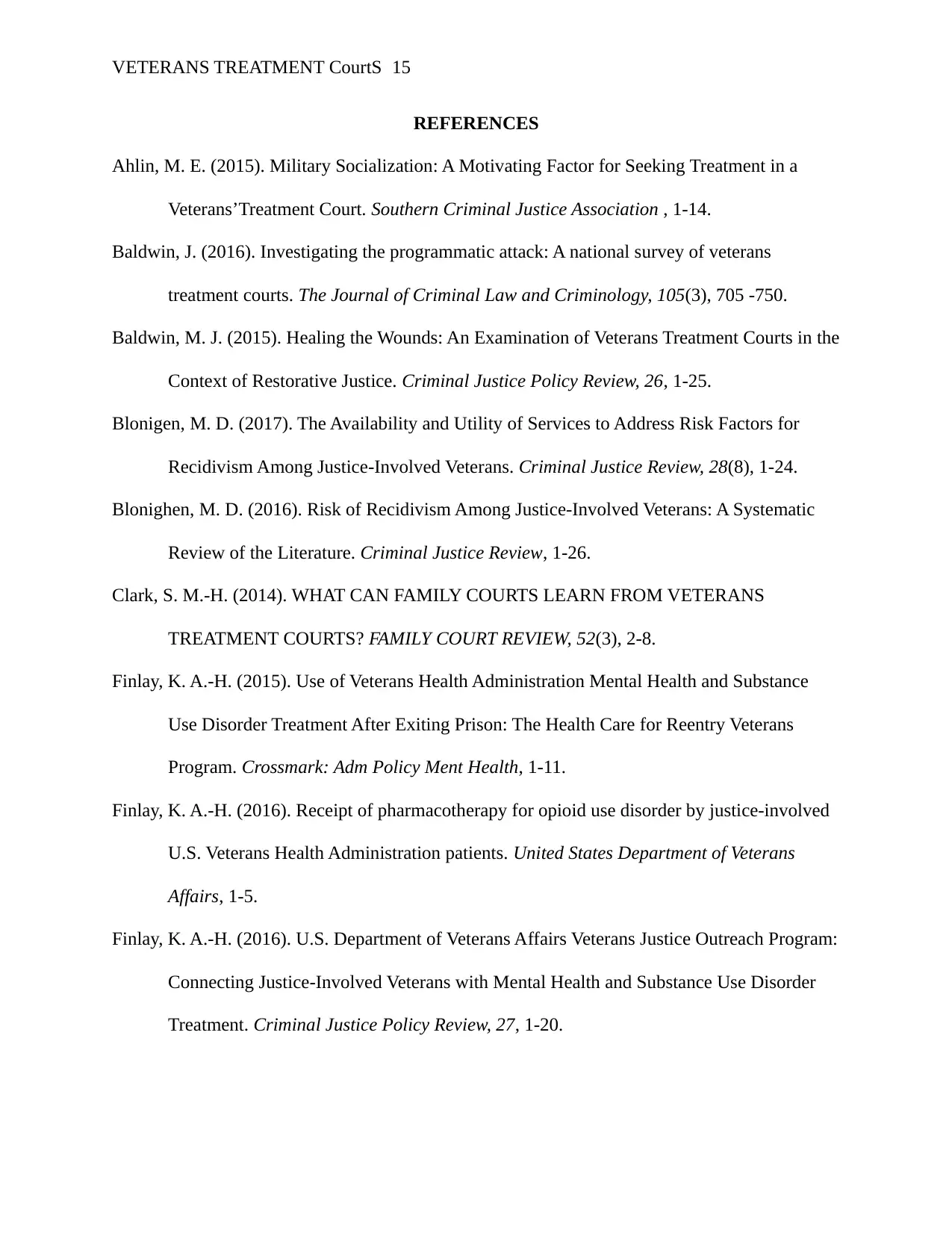
VETERANS TREATMENT CourtS 15
REFERENCES
Ahlin, M. E. (2015). Military Socialization: A Motivating Factor for Seeking Treatment in a
Veterans’Treatment Court. Southern Criminal Justice Association , 1-14.
Baldwin, J. (2016). Investigating the programmatic attack: A national survey of veterans
treatment courts. The Journal of Criminal Law and Criminology, 105(3), 705 -750.
Baldwin, M. J. (2015). Healing the Wounds: An Examination of Veterans Treatment Courts in the
Context of Restorative Justice. Criminal Justice Policy Review, 26, 1-25.
Blonigen, M. D. (2017). The Availability and Utility of Services to Address Risk Factors for
Recidivism Among Justice-Involved Veterans. Criminal Justice Review, 28(8), 1-24.
Blonighen, M. D. (2016). Risk of Recidivism Among Justice-Involved Veterans: A Systematic
Review of the Literature. Criminal Justice Review, 1-26.
Clark, S. M.-H. (2014). WHAT CAN FAMILY COURTS LEARN FROM VETERANS
TREATMENT COURTS? FAMILY COURT REVIEW, 52(3), 2-8.
Finlay, K. A.-H. (2015). Use of Veterans Health Administration Mental Health and Substance
Use Disorder Treatment After Exiting Prison: The Health Care for Reentry Veterans
Program. Crossmark: Adm Policy Ment Health, 1-11.
Finlay, K. A.-H. (2016). Receipt of pharmacotherapy for opioid use disorder by justice-involved
U.S. Veterans Health Administration patients. United States Department of Veterans
Affairs, 1-5.
Finlay, K. A.-H. (2016). U.S. Department of Veterans Affairs Veterans Justice Outreach Program:
Connecting Justice-Involved Veterans with Mental Health and Substance Use Disorder
Treatment. Criminal Justice Policy Review, 27, 1-20.
REFERENCES
Ahlin, M. E. (2015). Military Socialization: A Motivating Factor for Seeking Treatment in a
Veterans’Treatment Court. Southern Criminal Justice Association , 1-14.
Baldwin, J. (2016). Investigating the programmatic attack: A national survey of veterans
treatment courts. The Journal of Criminal Law and Criminology, 105(3), 705 -750.
Baldwin, M. J. (2015). Healing the Wounds: An Examination of Veterans Treatment Courts in the
Context of Restorative Justice. Criminal Justice Policy Review, 26, 1-25.
Blonigen, M. D. (2017). The Availability and Utility of Services to Address Risk Factors for
Recidivism Among Justice-Involved Veterans. Criminal Justice Review, 28(8), 1-24.
Blonighen, M. D. (2016). Risk of Recidivism Among Justice-Involved Veterans: A Systematic
Review of the Literature. Criminal Justice Review, 1-26.
Clark, S. M.-H. (2014). WHAT CAN FAMILY COURTS LEARN FROM VETERANS
TREATMENT COURTS? FAMILY COURT REVIEW, 52(3), 2-8.
Finlay, K. A.-H. (2015). Use of Veterans Health Administration Mental Health and Substance
Use Disorder Treatment After Exiting Prison: The Health Care for Reentry Veterans
Program. Crossmark: Adm Policy Ment Health, 1-11.
Finlay, K. A.-H. (2016). Receipt of pharmacotherapy for opioid use disorder by justice-involved
U.S. Veterans Health Administration patients. United States Department of Veterans
Affairs, 1-5.
Finlay, K. A.-H. (2016). U.S. Department of Veterans Affairs Veterans Justice Outreach Program:
Connecting Justice-Involved Veterans with Mental Health and Substance Use Disorder
Treatment. Criminal Justice Policy Review, 27, 1-20.
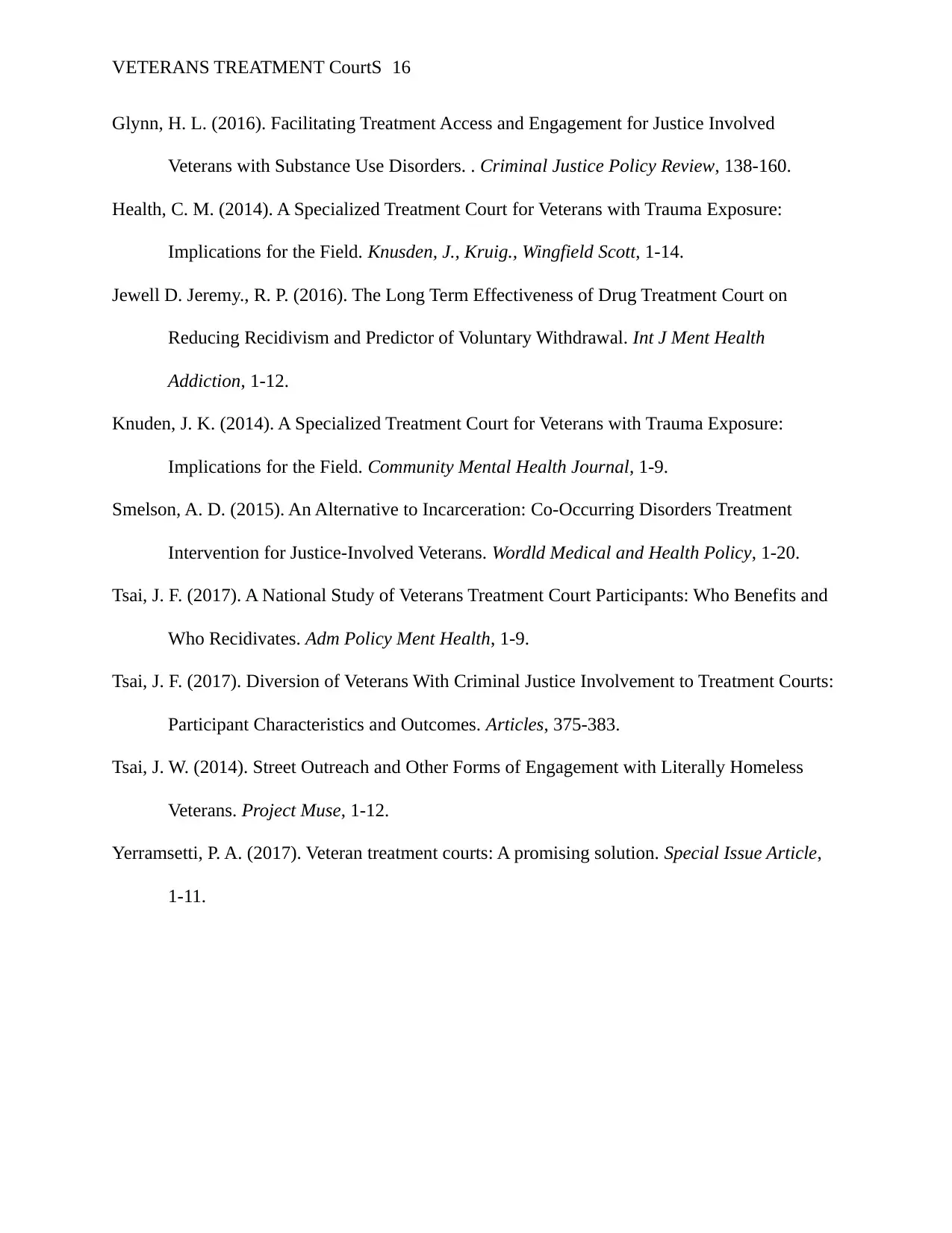
VETERANS TREATMENT CourtS 16
Glynn, H. L. (2016). Facilitating Treatment Access and Engagement for Justice Involved
Veterans with Substance Use Disorders. . Criminal Justice Policy Review, 138-160.
Health, C. M. (2014). A Specialized Treatment Court for Veterans with Trauma Exposure:
Implications for the Field. Knusden, J., Kruig., Wingfield Scott, 1-14.
Jewell D. Jeremy., R. P. (2016). The Long Term Effectiveness of Drug Treatment Court on
Reducing Recidivism and Predictor of Voluntary Withdrawal. Int J Ment Health
Addiction, 1-12.
Knuden, J. K. (2014). A Specialized Treatment Court for Veterans with Trauma Exposure:
Implications for the Field. Community Mental Health Journal, 1-9.
Smelson, A. D. (2015). An Alternative to Incarceration: Co-Occurring Disorders Treatment
Intervention for Justice-Involved Veterans. Wordld Medical and Health Policy, 1-20.
Tsai, J. F. (2017). A National Study of Veterans Treatment Court Participants: Who Benefits and
Who Recidivates. Adm Policy Ment Health, 1-9.
Tsai, J. F. (2017). Diversion of Veterans With Criminal Justice Involvement to Treatment Courts:
Participant Characteristics and Outcomes. Articles, 375-383.
Tsai, J. W. (2014). Street Outreach and Other Forms of Engagement with Literally Homeless
Veterans. Project Muse, 1-12.
Yerramsetti, P. A. (2017). Veteran treatment courts: A promising solution. Special Issue Article,
1-11.
Glynn, H. L. (2016). Facilitating Treatment Access and Engagement for Justice Involved
Veterans with Substance Use Disorders. . Criminal Justice Policy Review, 138-160.
Health, C. M. (2014). A Specialized Treatment Court for Veterans with Trauma Exposure:
Implications for the Field. Knusden, J., Kruig., Wingfield Scott, 1-14.
Jewell D. Jeremy., R. P. (2016). The Long Term Effectiveness of Drug Treatment Court on
Reducing Recidivism and Predictor of Voluntary Withdrawal. Int J Ment Health
Addiction, 1-12.
Knuden, J. K. (2014). A Specialized Treatment Court for Veterans with Trauma Exposure:
Implications for the Field. Community Mental Health Journal, 1-9.
Smelson, A. D. (2015). An Alternative to Incarceration: Co-Occurring Disorders Treatment
Intervention for Justice-Involved Veterans. Wordld Medical and Health Policy, 1-20.
Tsai, J. F. (2017). A National Study of Veterans Treatment Court Participants: Who Benefits and
Who Recidivates. Adm Policy Ment Health, 1-9.
Tsai, J. F. (2017). Diversion of Veterans With Criminal Justice Involvement to Treatment Courts:
Participant Characteristics and Outcomes. Articles, 375-383.
Tsai, J. W. (2014). Street Outreach and Other Forms of Engagement with Literally Homeless
Veterans. Project Muse, 1-12.
Yerramsetti, P. A. (2017). Veteran treatment courts: A promising solution. Special Issue Article,
1-11.
1 out of 16
Related Documents
Your All-in-One AI-Powered Toolkit for Academic Success.
+13062052269
info@desklib.com
Available 24*7 on WhatsApp / Email
![[object Object]](/_next/static/media/star-bottom.7253800d.svg)
Unlock your academic potential
© 2024 | Zucol Services PVT LTD | All rights reserved.





